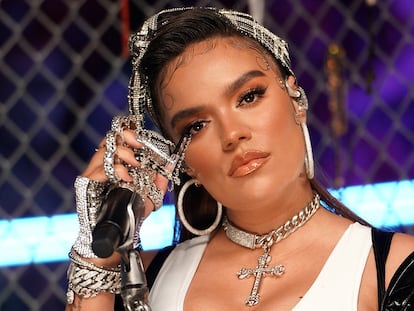Who is Karol G? Why Brazil still resists music in Spanish
From Colombian singer Karol G to Puerto Rican reggaeton star Bad Bunny, world-renowned Spanish-language musicians are complete strangers to the majority of Brazilians. In Latin America’s largest country, none of the most-played songs are in Spanish. Rather, they tend to be locally-produced and sung in Portuguese

Colombian artist Karol G — winner of the Latin Grammy Award for Album of the Year — spent the better part of 2023 filling stadiums in Latin America and the U.S. She’s now preparing to repeat the feat in Europe. To give just one example, in Madrid, tickets to her concert were sold out in seven minutes.
In Brazil, on the other hand — a country bordering her native country — she’s unknown to the vast majority. But this isn’t anything new: Brazil doesn’t follow along with the rest of Latin America in many aspects, including music. Portuguese is the most obvious barrier, but it’s not the only one. With the entire world — both Spanish and non-Spanish speaking — having surrendered to reggaeton, the indifference that Brazil has towards what’s happening in its neighboring countries is even more perplexing.
Among the 150 most-listened-to artists of 2023 on Spotify Brazil, none of them sing in Spanish. The absolute queen was Ana Castela, a very young sertanejo singer. This genre — a kind of Brazilian country music, filled with lyrics about romantic disappointments and nights of drinking cachaça to drown one’s sorrows — has grown like wildfire in recent years, almost becoming a monoculture. Sertanejo dominates the list of the 10 most-listened-to artists of the year in Brazil. The only foreigner in that select group is Taylor Swift, in ninth place.
Brazil has long had difficulties listening to music in Spanish, according to Analía Chernavsky, a professor at the Federal University of Latin American Integration (UNILA) in Foz de Iguazú. She explains that the phenomenon — despite being known to everyone — has barely been studied in academia. “In addition to the language barrier, there’s a shared historical narrative among Spanish-speaking Latin American countries, in which Brazil doesn’t participate. In schools [in the region] Brazil is always taught as an aside, and that ends up forming [a distinct] musical culture,” she tells EL PAÍS by phone.
There’s another factor that’s key here. With more than 210 million inhabitants and vast cultural diversity, Brazil has so much musical wealth and such a powerful music industry that the country is self-sufficient. The sertanejo is now the king of kings, but there are genres for all tastes… and all are made in Brazil. These range from the samba, the pagode and the bossa nova, to the piseiro, the axé, the frevo, the forró, the tecnobrega, the arrocha or the great umbrella that’s Brazilian popular music (MPB). Brazil even has a large scene of drag queen divas, including Pabllo Vittar or Gloria Groove, true stars that attract the masses.
Funk deserves an entirely separate chapter. The resounding sound was born in the favelas and peripheries of Rio de Janeiro. The strength of funk, in fact — with names that have brought it to the mainstream for all audiences, such as Anitta or Ludmilla — is one of the main containment dams that prevents the entry of reggaeton into Brazil. “The Brazilian market produces and consumes right here, it’s self-sufficient. Brazilian funk is correlative to the reggaeton of the Latin American environment. It’s the same niche,” Chernavsky notes.
The perreo genre is experiencing a golden era. The number of reggaeton listeners increased by 95% worldwide between 2019 and 2023. In Colombia, there was an explosion: a growth of 333%, according to data from Spotify. But Brazil didn’t surrender to that boom. Maluma or J Balvin had relative success in the country a few years ago, but only after collaborating with Anitta — the great national star — and taking risks with Portuguese versions of their songs.
Anitta, in fact, is a good representation of two worlds that don’t understand each other. The Brazilian was determined to teach the world about the funk that she grew up with in a neighborhood in the north of Rio. It hasn’t been easy for her. Her biggest international hit to date — Envolver — is a reggaeton song sung in Spanish.
Spanish speakers find it difficult to listen to funk, and Brazilians find it difficult to listen to reggaeton. Anitta seems to have found the definitive strategy in her Pan-American evangelizing mission, giving each audience what they ask for. She’s just released two singles at the same time: for the Spanish market, the reggaeton song Bellakeo, alongside Mexican singer Peso Pluma. For Brazilians, she put out the funk song Joga Pra Lua, collaborating with fellow Brazilian artists Dennis and Pedro Sampaio.
“I think the last song in Spanish that was successful in Brazil was Despacito,” says Isabel Amorim, executive superintendent of ECAD, the Brazilian entity that manages copyrights. Luis Fonsi’s hit dates back to 2017. In Brazil, it became more popular thanks to the English remix, in which Justin Bieber participated. Even so, it barely managed to become the 29th most-played song on Brazilian radio that year.
The greater inclination towards English rather than Spanish also occurs with Latin artists who sing in both languages. A curious case is that of Shakira. Brazilians sing Waka Waka in its English version. And despite the popularity of her line “Las mujeres ya no lloran, las mujeres facturan” (women no longer cry, women make money), Brazil hasn’t paid much attention to the Colombian artist’s attacks on Gerard Piqué. At parties in Brazil, the Shakira song that unleashes excited chants continues to be Estoy Aquí, which is about to turn 29-years-old.
Just like in much of the world after the pandemic, this past year, Brazil registered exponential growth in concerts and festivals. The ECAD handed out licenses for 34,156 concerts, representing 50.3% more than in 2022. It’s often said that Brazil is distant from international music circuits and that, for foreign artists, visiting this continental-sized country isn’t profitable. However, in recent months, Coldplay, the Red Hot Chilli Peppers, The Weeknd, Taylor Swift, Roger Waters and Paul McCartney, among many others, have passed through Brazil.
But Spanish-speaking Latin American artists are, once again, the great absentees. Last year, Bad Bunny took his world tour to 15 Latin American stadiums, but bypassed Brazil. It simply didn’t make sense for him, as there wasn’t enough demand. Karol G — the latest hit in Latin music — will give a single concert in Brazil this coming May, in São Paulo, in a room with capacity for just 8,000 people. Meanwhile, the incombustible Ivete Sangalo — one of Brazil’s most beloved singers — just filled the Maracaná stadium in Rio de Janeiro with tens of thousands of fans, to celebrate her 30-year-long career.
Sign up for our weekly newsletter to get more English-language news coverage from EL PAÍS USA Edition
Tu suscripción se está usando en otro dispositivo
¿Quieres añadir otro usuario a tu suscripción?
Si continúas leyendo en este dispositivo, no se podrá leer en el otro.
FlechaTu suscripción se está usando en otro dispositivo y solo puedes acceder a EL PAÍS desde un dispositivo a la vez.
Si quieres compartir tu cuenta, cambia tu suscripción a la modalidad Premium, así podrás añadir otro usuario. Cada uno accederá con su propia cuenta de email, lo que os permitirá personalizar vuestra experiencia en EL PAÍS.
¿Tienes una suscripción de empresa? Accede aquí para contratar más cuentas.
En el caso de no saber quién está usando tu cuenta, te recomendamos cambiar tu contraseña aquí.
Si decides continuar compartiendo tu cuenta, este mensaje se mostrará en tu dispositivo y en el de la otra persona que está usando tu cuenta de forma indefinida, afectando a tu experiencia de lectura. Puedes consultar aquí los términos y condiciones de la suscripción digital.
More information
Archived In
Últimas noticias
Maduro pleads not guilty before the federal court in New York: ‘I am still the president of Venezuela’
A new test can detect Alzheimer’s from a finger prick
UN team enters Sudanese city of El Fasher after paramilitary massacre: ‘It’s like a ghost town’
A recipe for resistance: Indigenous peoples politicize their struggles from the kitchen
Most viewed
- Gilles Lipovetsky: ‘If you want to live better and fall in love, take Prozac, don’t look to philosophy’
- Alain Aspect, Nobel laureate in physics: ‘Einstein was so smart that he would have had to recognize quantum entanglement’
- Alvin Hellerstein, a 92-year-old judge appointed by Bill Clinton, to preside over Maduro’s trial in New York
- Why oil has been at the center of Venezuela-US conflicts for decades
- Maduro’s downfall puts China’s relationship with Venezuela to the test










































